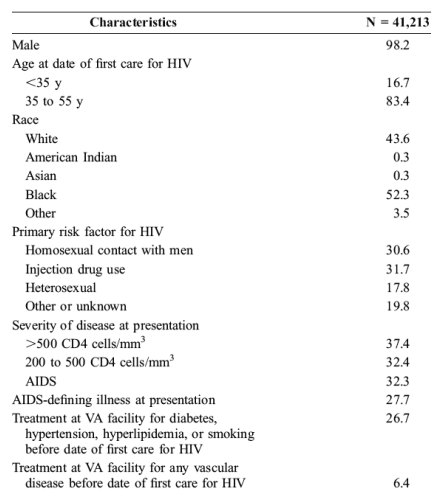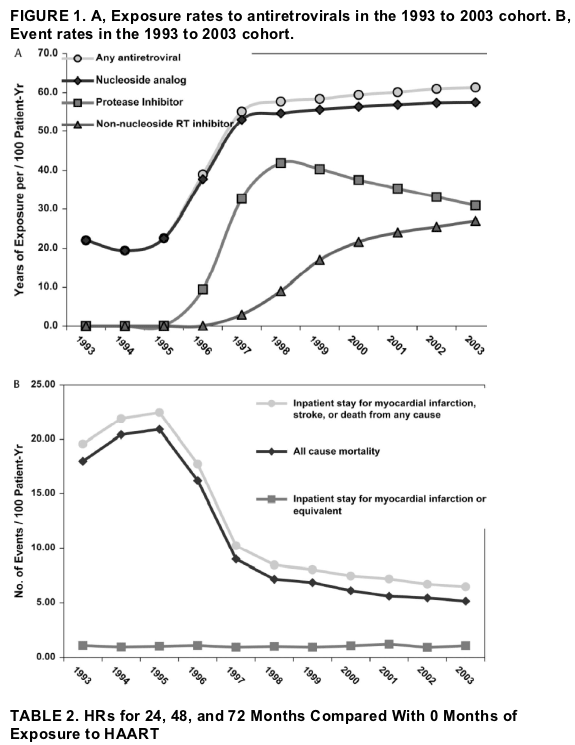| |
Long-Term Survival and Serious Cardiovascular Events in HIV-Infected Patients Treated With Highly Active Antiretroviral Therapy in VA
[Brief Report: Clinical Science]
|
| |
| |
JAIDS Journal of Acquired Immune Deficiency Syndromes:Volume 47(3)1 March 2008pp 338-34
Bozzette, Samuel A MD, PhD*; Ake, Christopher F PhD*; Tam, Henry K PhD*; Phippard, Alba MPH*; Cohen, David MS; Scharfstein, Daniel O PhD; Louis, Thomas A PhD
From the *Veterans Medical Research Foundation and Veterans Affairs Quality Enhancement Research Initiative for HIV at the Veterans Affairs San Diego Health Care System, San Diego, CA; Department of Medicine, University of California, San Diego, La Jolla, CA; RAND Corporation, Santa Monica, CA; and Department of Biostatistics, Johns Hopkins Bloomberg School of Public Health, Baltimore, MD.
Supported by the Quality Enhancement Research Initiative of the Veterans Affairs Health Services Research and Development Service and by the sponsors of the Oversight Committee for the Evaluation of the Metabolic Complications of Highly Active Antiretroviral Therapy convened by the European Medicines Agency, including Abbott Laboratories, Boehringer Ingelheim, Bristol-Myers Squibb, Gilead Sciences, GlaxoSmithKline, F. Hoffmann-LaRoche, Merck Research Laboratories, and Pfizer.
Summary:
There is continuing interest in the longer term effects of highly active antiretroviral therapy (HAART) on the risk of cardiopulmonary events. We assessed this using updated administrative data from an open retrospective cohort of HIV-infected persons receiving care from the US Veterans Affairs (VA). Information on 41,213 HIV-infected patients receiving VA care between January 1993 and December 2003 was included. Patients were followed for an average of 4 years or 168,213 person-years of follow-up. The death rate fell from 20.9 deaths per 100 patient-years of observation in 1995 to 5.2 deaths per 100 patient-years in 2003. In patient-level analysis, adjusted hazard ratios for death dropped precipitously for all races to a low of 0.18 (95% confidence interval: 0.15 to 0.23) at 72 months of exposure to HAART. Hazards for serious cardiovascular events remained near 1.0 for exposure to HAART, and hazards for serious cardiovascular events, stroke, or death were only slightly higher than for death alone. No selection effects or secular trends were found. The benefits of HAART continued to increase in the 8 years after introduction and with 6 years of individual use. The risk of serious cardiovascular events should be factored into individual patient management but does not pose an important public health risk.
Our previous outcomes study of more than 38,000 HIV-infected patients seen at US Veterans Affairs (VA) health care facilities found that the use of regimens containing protease inhibitors (PIs) or nonnucleoside reverse transcriptase inhibitors (NNRTIs) was associated with a sharply decreased hazard for death but not with the risk of hospitalization for serious cardiovascular events or stroke.1 The developing literature still contains conflicting studies, and there is interest in the possibility of late toxicity.2-5 For these reasons, we have extended our prior study of patients in a realistic clinical setting with low financial barriers to access.
DISCUSSION
We previously concluded that the benefits of indicated antiretroviral therapy administered in a naturalistic setting far outweighed any possible increased risk of serious cardiovascular events. After a substantial increase in the size of the cohort and in the duration and amount of exposure to antiretrovirals, ecologic data and patient-level models indicate a durable and increasing survival benefit to HAART over time. In this same cohort, there was no increase in the rate of serious cardiovascular events over calendar time, and patient-level models showed no increasing risk at 24, 48, or 72 months of exposure. This lack of association was true even in models designed to interrupt channeling, or feedback between cardiovascular risk and the decision to expose patients to particular treatments. Finally, overall benefits nearly identical to those for survival were seen for a composite outcome that effectively treats serious vascular events as equivalent to death.
Other authors have also found no association between HIV treatment and serious cardiovascular events in retrospective studies. One clinical trial found an association between continuous antiretroviral therapy and a decrease in short-term risk for myocardial infarction, possibly because of a reversal of HIV's adverse effects on endothelial functioning.5 The largest prospective study found a statistically significant increase in the risk of myocardial infarction associated with HAART, particularly with the use of PIs.3 (DAD Cohort) The effect was small relative to the survival benefit of treatment, however, and was partially explained by lipid abnormalities. The finding also may have been affected by this study's pseudocohort design. In which most patients started HAART well before the beginning of observation, or by other methodology issues.6
Small effects could be missed by studies that draw on administrative data or include cohorts that are atypical. Our use of administrative data limited covariate adjustment, because we only had information on treatment of risk factors. This cohort is essentially all men who are generally older than and somewhat earlier in the course of their disease than the overall population of people with HIV disease. Despite these limitations, our results continue to be consistent with a negligible public health risk from cardiovascular complications of HAART. Perhaps more importantly, they are again consistent with an increasingly powerful survival benefit from HAART. This underscores the importance of access to skillful antiretroviral therapy and of treatment of risk factors for comorbidity and mortality.
METHODS
This is a retrospective cohort study of care given to known HIV-infected patients by the Department of Veterans Affairs between January 1993 and December 2003. We updated our previous cohort by adding 2.5 years of additional follow-up, 4139 new entrants to care, and 1119 persons newly found to have HIV, and by removing 811 persons found to not have HIV.6 The project was approved by the Joint Committee on Human Subjects at the University of California, San Diego and the VA San Diego Healthcare System.
Data were cleaned as previously reported. Multiple imputation was used to replace missing values for race, risk factor, and severity of illness on 7%, 12%, and 0.5% of patients. Outcomes were all-cause mortality, inpatient stay for serious cardiovascular events such as myocardial infarction or coronary artery bypass, and inpatient stay for serious cardiovascular events or stroke or death, all as previously defined. Patient-level event-time models were estimated on data arranged into counting process format to accommodate staggered entry and exit. Patients were censored at the end of the study, death, or 6 months after the last VA care. All models included year of and age at first VA HIV care; race; ethnicity; gender; risk group; disease severity; history of AIDS-defining diagnosis; diagnosis of drug abuse; and prior treatment for serious vascular disease, diabetes, hypertension, hyperlipidemia, or smoking. Models also included time-varying covariates for calendar year and linear, squared, and cubed terms for months on specific therapies and were estimated for different time periods to evaluate secular trends. P values for hazard ratios (HRs) were derived from Wald tests of the joint vector of all parameter estimates.
We developed instrumental variable survival time regression with time-varying covariates to evaluate the effects of channeling of patients to different treatments. This approach substitutes instruments, variables that predict treatment but not outcome, for treatment.7 Here, a logistic treatment selection model of (treatment given instrument and covariates) was developed, and an (outcome given instrument) model was then produced by using the former model to generate a weighted average of the (outcome given treatment) model. The instrumental variables were facility switching, the proportion of visits followed by a visit to another location, because patients who switch may be less likely to receive highly active antiretroviral therapy (HAART); National Alliance of State and Territorial AIDS Directors rating of generosity, a score based on limitations to AIDS Drug Assistance Program/Medicaid, because veterans in less generous states may be driven to the VA for HAART; and clinic aggressiveness, the proportion of all patients at a site on HAART, because patients in more aggressive clinics may be more likely to get HAART.
RESULTS
This study included 41,213 persons followed for an average of 4 years (Table 1; see tables below). There were 77,944, 42,406, and 21,441 patient-years of exposure to nucleoside reverse transcriptase inhibitors (NRTIs), PIs, and NNRTIs, respectively (Fig. 1A). More than 17,000 patients had at least 4 years of follow-up. There were 17,558 deaths, 1735 inpatient stays for serious cardiovascular events, and 19,898 occurrences of death or admission for serious cardiovascular events or stroke. All-cause mortality dropped from 20.9 deaths per 100 patient-years of observation in 1995 to 5.2 deaths per 100 patient-years of observation in 2003 (see Fig. 1B). Rates of inpatient stay for serious cardiovascular events were stable during the HAART era.
Adjusting for HIV treatment, the relative hazards for inpatient stay for serious cardiovascular events, death, and death or inpatient stay for serious cardiovascular events or stroke were all higher for older patients (HR = 1.05, 95% confidence interval [CI]: 1.05 to 1.06; HR = 1.03, 95% CI: 1.02 to 1.03; and HR = 1.03, 95% CI: 1.03 to 1.03, respectively) and for those with preexisting vascular disease (HR = 4.01, 95% CI: 3.39 to 4.76; HR = 1.55, 95% CI: 1.46 to 1.64; and HR = 1.71, 95% CI: 1.61 to 1.81, respectively). Risk of serious cardiovascular events was lower for African Americans (HR = 0.80, 95% CI: 0.69 to 0.93).
Compared with no therapy, there was an increasing survival benefit with increasing time of exposure to HAART (HR for 72 months of treatment = 0.18, 95% CI: 0.15 to 0.23) that included a PI or NNRTI (Table 2). Similar benefit was seen for the composite outcome of death, serious cardiovascular event, or stroke and for models comparing HAART with all other forms of therapy. The relative hazard for serious cardiovascular events was not different from 1.0 for all 3 classes of HAART at 24, 48, and 72 months of exposure. For serious cardiovascular events, the estimated 48-month hazard was similar for Cox models (HR = 1.16, 95% CI: 0.86 to 1.57) and for instrumental variable models using facility switching (HR = 1.14, 95% CI: 0.72 to 1.82), NASTAD rating of state generosity (HR = 1.14, 95% CI: 0.72 to 1.83), or clinic aggressiveness (HR = 1.14, 95% CI: 0.71 to 1.82), suggesting that selection of lower risk patients for initiation or continuation of treatment did not affect the results. In addition, findings were similar for the periods 1996 to 1999 and 2000 to 2003 considered separately.
REFERENCES
1. Bozzette SA, Ake CF, Tam HK, et al. Cardiovascular and cerebrovascular events in patients treated for human immunodeficiency virus infection. N Engl J Med. 2003;348:702-710.
2. Sterne JAC, May M, Ledergerber B, et al. HAART and the heart: changes n coronary risk factors and implications for coronary risk in men starting antiretroviral therapy. J Intern Med. 2007;261:255-267.
3. DAD Study Group, Friis-Moller N, Reiss P, Sabin CA, et al. Class of antiretroviral drug and the risk of myocardial infarction. N Engl J Med. 2007;356:1723-1735.
4. Lichtenstein K, Armon C, Buchacz K, et al. Analysis of cardiovascular risk factors in the HIV Outpatient Study Cohort [abstract 735]. Presented at: 13th Conference on Retroviruses and Opportunistic Infections; 2006; Denver. Available at: http://www.retroconference.org/2006/Abstracts/26499.HTM . Accessed February 2006.
5. El-Sadr WM, Lundgren JD, Neaton JD, et al. CD4+ count-guided interruption of antiretroviral treatment. N Engl J Med. 2006;355:2283-2296.
6. Hughes MD, Williams PL. Challenges in using observational studies to evaluate adverse effects of treatment. N Engl J Med. 2007;356:1705-1707.
7. McIntosh MW. Instrumental variables when evaluating screening trials. Estimating the benefit of detecting cancer by screening. Stat Med. 1999;18:2775-2794.
TABLE 1. Selected Characteristics of VA Patients With Known
HIV Infection, 1993 to 2003. Of note, 98% are men; 83% 35-55 yrs old; 52% black, 43% white; 31% IDU primary risk for HIV, 30% homosexual contact; severity of disease at presentation: 37% cd4>500, 32% 200-500, 32% AIDS; treatment at VA for hypertension, hyperlipidemia, or smoking before date of first care for HIV 26%; treatment at VA for any vascular disease before date of first care foe HIV: 6.4%.



|
|
| |
| |
|
|
|